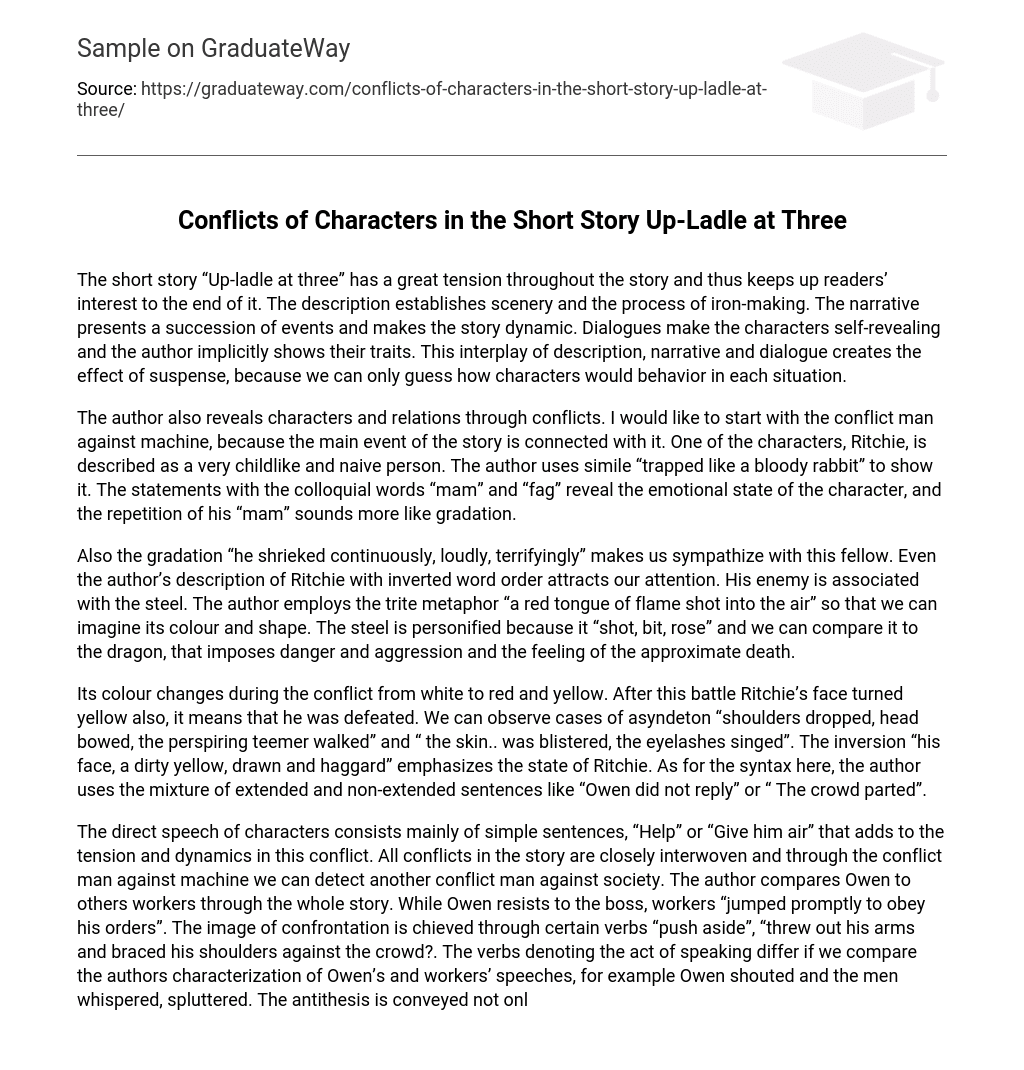The short story “Up-ladle at three” has a great tension throughout the story and thus keeps up readers’ interest to the end of it. The description establishes scenery and the process of iron-making. The narrative presents a succession of events and makes the story dynamic. Dialogues make the characters self-revealing and the author implicitly shows their traits. This interplay of description, narrative and dialogue creates the effect of suspense, because we can only guess how characters would behavior in each situation.
The author also reveals characters and relations through conflicts. I would like to start with the conflict man against machine, because the main event of the story is connected with it. One of the characters, Ritchie, is described as a very childlike and naive person. The author uses simile “trapped like a bloody rabbit” to show it. The statements with the colloquial words “mam” and “fag” reveal the emotional state of the character, and the repetition of his “mam” sounds more like gradation.
Also the gradation “he shrieked continuously, loudly, terrifyingly” makes us sympathize with this fellow. Even the author’s description of Ritchie with inverted word order attracts our attention. His enemy is associated with the steel. The author employs the trite metaphor “a red tongue of flame shot into the air” so that we can imagine its colour and shape. The steel is personified because it “shot, bit, rose” and we can compare it to the dragon, that imposes danger and aggression and the feeling of the approximate death.
Its colour changes during the conflict from white to red and yellow. After this battle Ritchie’s face turned yellow also, it means that he was defeated. We can observe cases of asyndeton “shoulders dropped, head bowed, the perspiring teemer walked” and “ the skin.. was blistered, the eyelashes singed”. The inversion “his face, a dirty yellow, drawn and haggard” emphasizes the state of Ritchie. As for the syntax here, the author uses the mixture of extended and non-extended sentences like “Owen did not reply” or “ The crowd parted”.
The direct speech of characters consists mainly of simple sentences, “Help” or “Give him air” that adds to the tension and dynamics in this conflict. All conflicts in the story are closely interwoven and through the conflict man against machine we can detect another conflict man against society. The author compares Owen to others workers through the whole story. While Owen resists to the boss, workers “jumped promptly to obey his orders”. The image of confrontation is chieved through certain verbs “push aside”, “threw out his arms and braced his shoulders against the crowd?. The verbs denoting the act of speaking differ if we compare the authors characterization of Owen’s and workers’ speeches, for example Owen shouted and the men whispered, spluttered. The antithesis is conveyed not only through verbal part of the text but also with the help of other lexical means, as “his eyes burned” and “his eyes full of fear”, “Owen.. clutched him by the throat” and “they tore Owen’s hands away from the foreman’s throat”.
The conflict is not resolved, because the semantic field of fear is preserved, “full of fear, desperate with fear, glanced nervously, whispered nervously, transfixed” and the workers don’t know what side to chose. They are described as a flock of sheep because the word “crowd” is repeated several times. Squint involves Owen into another conflict man against man, though it is connected with this one. The nickname Squint speaks for itself as if he always looks at people with suspicion, doubt or envy. His body language and the use of imperative mood show his superiority over other workers.
He stood with his arms folded, he peered at them. He is not satisfied with Owen and body language and the future tens in his warnings adds to this fact, ‘He raised his hand threateningly’ , ‘shook his fist’. ‘you will answer for this’. Owen seems to be very strong-willed, he knows how to reach his communicative aim asking tag-questions “you don’t intend casting that spindle, do you? ” , insisting on the positive answer. In the beginning his grammar and phonetics seem to be correct because he uses complex sentences, while Squint prefers simple sentences and contracted forms “d’you”.
But the situation changes after the death. Owen yields to emotions and his speech becomes full of colloquial words as ‘pal’ ‘fellers’. Squint’s behavior also differ. The author uses simile to show this transformations “Squint trembled like a man afflicted with ague. ”. But Owen handles this situation, he tries to be convincing he uses a lot of repetitions of words “Accident “ , roots “murder”. The author compares Owen to an animal “clutched him, hissed between his bared teeth. A set of rhetorical questions and literary words “affair” and the passive structures make his appeal more vivid.
At the end of this story Squint looks like a common worker, the repetitions of the word “shuffle back “ , the use of the pronoun we that stands for the workers and him show that he is looking for the support among other workers. As the workers don’t know which side to choose this conflict remains unsolved. All that syntactical and lexical means help to build up tension and create an effect of suspense that transmit the message to the reader gradually. We should be human beings. And if the person has gone we cant compensate him, we should take responsibilities for our actions.





